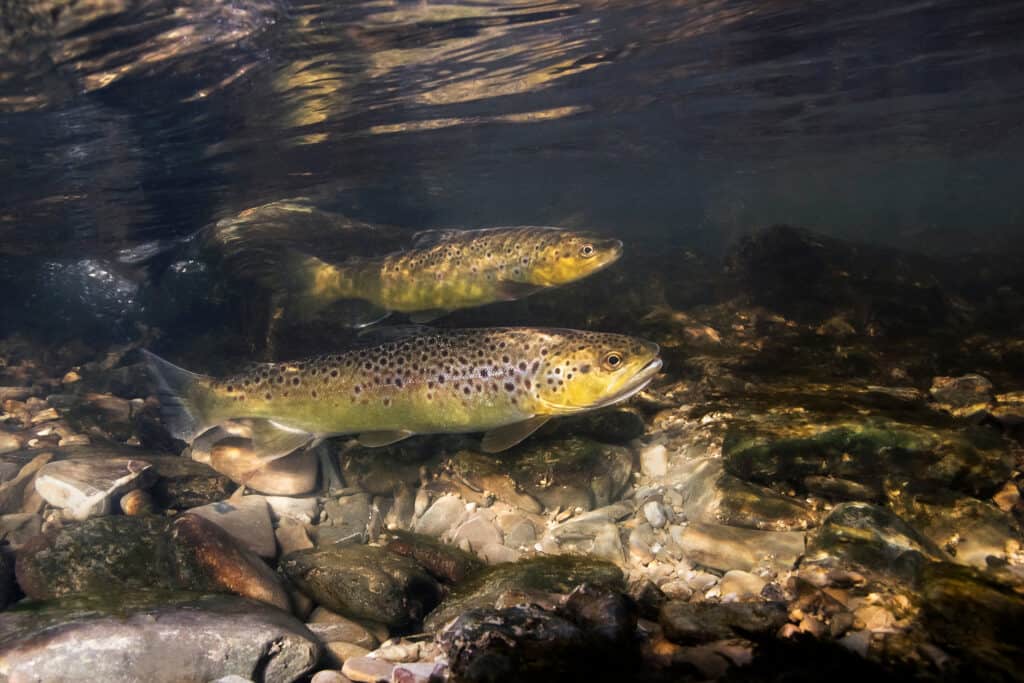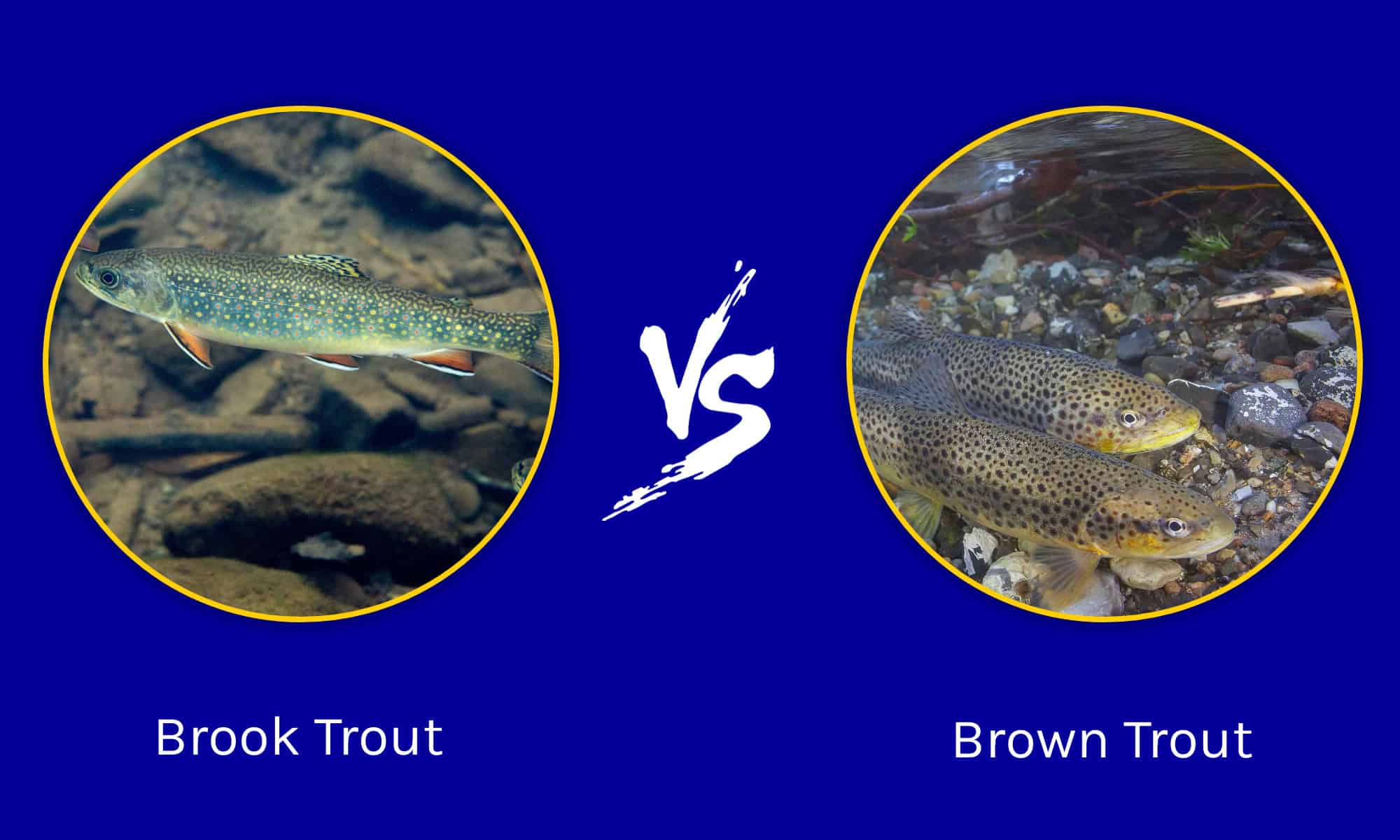Brook trout and brown trout are both excellent game fish that put up a fight and create plenty of excitement for anglers. The trouble is, they are similar-looking fish, and telling them apart is tricky. This article will explore brook trout vs. brown trout: four key differences, so it’s easy to identify the next time you hook a whopper.
Species Overview
Brook Trout
Brook trout (Salvelinus fontinalis) is a many-named fish. Anglers call it eastern brook trout, brook charr, squaretail, mud trout, and coaster trout.
It’s a member of the Salmonidae family, and it’s native to Eastern North America and Canada. Brook trout is such a popular sport fish. Europe introduced it to their waters in 1869. Since then, other regions have introduced it, including the rest of North America, South America, Asia, Africa, and Oceania.
Brook trout is the state fish of the following states:
- Michigan
- New Hampshire
- New Jersey
- New York
- North Carolina
- Pennsylvania
- Vermont
- Virginia
- West Virginia

The Brook Trout is so popular it has been named the state fish of nine U.S. states.
©M Rose/Shutterstock.com
Brown Trout
Brown trout (Salmo trutta) is also a member of the Salmonidae family, but unlike brook trout, it’s native to Europe and Asia. Introduced to North America in 1883, it’s become a popular sport fish and established a wild population. It isn’t a state fish in North America.

The brown trout was introduced to North America in 1883. It’s become a popular sport fish and established a wild population.
©Rostislav Stefanek/Shutterstock.com
Brook Trout vs. Brown Trout Appearance
Both brook trout and brown trout have spots, and they’re the same long shape that’s fatter at the center, but here are the key differences between a brook trout vs. a brown trout’s appearance:
Brook trout appear dark green to brown with vivid marbling on the flanks and red dots with blue circles spanning the back and sides. Pale brown or reddish bellies darken to orange during spawning. (It’s important to put back any brook trout with an orange belly to ensure strong populations). Brook trout also have a distinctive white margined lower fin and tail.
In contrast, a brown trout is greeny-brown with a coppery-brass back and sides that merge into a cream-to-white belly. On occasion, brown trout sport brown or black-spotted sides with cream halos. Brown trout do not have brook trout’s distinctive white margined lower fins and tail.
Size of Brook Trout vs. Brown Trout
Brook trout vary in size depending on age and their environment. On average, adults reach eight to 24 inches long and weigh up to 10 lbs. Adults live on average at least seven years, but anglers report grandad aged 15-year-old brook trout in California.
Brown trout size varies, too. In small rivers, they reach 12 -14 inches long and weigh two to 10 lbs, but in large environments can make 20 inches and 20-40 lbs on the scales. Brown trout can live up to 20 years, but few make it to that grand old age.
Key Appearance Differences
The easiest ways to tell a brook trout from a brown trout are the spot color, back markings, and fin/tail margin. If spots are lighter than their body, it’s most likely a brook trout. If the spots are darker than the body, it’s more likely a brown trout. The blue circles give the game away, too. Blue circles belong to brook trout.
Another excellent giveaway is a brook trout’s marbled back that’s covered in squiggles and wavy lines. A brown trout is much plainer, with barely any spots or squiggles on the back or tail areas.
And finally, a brown trout won’t have white margined fins or tails.
Brook Trout vs. Brown Trout Habitat
Our two fish like the same habitat types, but brook trout prefer clear water.
Brook trout sound as though they live in brooks, which is true to an extent. As well as brooks, these beautiful fish inhabit creeks, ponds, large lakes, and fast-flowing rivers. They need fast-flowing water to grab their prey as it passes by this ambush hunter.
In contrast, brown trout prefer clear, cold streams with plenty of cover. Brown trout hide around fallen logs, submerged vegetation, and overhanging vegetation, darting out to grab prey. They don’t manage well in warm water, preferring ice-cold temperatures. They’re more likely to live in slow-moving waters than brook trout.
Brook Trout vs. Brown Trout: Diet
Although they hunt in different ways, brook and brown trout eat a similar diet.
Both fish species eat aquatic insects like mayflies and caddis flies, crustaceans, mollusks, frogs, smaller fish, invertebrates, and any small animals unlucky enough to fall into the water, such as ants, crickets, and beetles.
Young brook and brown trout generally eat insects and mollusks, whereas adults chiefly eat smaller fish.
Brook Trout vs. Brown Trout: Spawn
Both brook trout and brown trout spawn from October to December in the U.S., and both species do it the same way.
Female trout spawn in moving stream beds so the eggs are fully oxygenized by moving water. A female digs a depression lays her eggs, and a male trout fertilizes them. Following fertilization, the female buries her eggs with sediments, and they hatch about 100 days later into fry.
During this time, the parent fish stay nearby and protect the nest until hatching starts.
What Predators Do They Have?
Brook and brown trout are large predatory fish, and adults have few predators other than hawks and humans, but fry, and juveniles’ predators are numerous.
They include:
- Northern water snakes
- Herons
- Kingfishers
- Otters
- Snapping turtles
- Adult trout and other large carnivorous fish

Juvenile trout are prey to many species, including otters.
©iStock.com/Mirko_Rosenau
Brook Trout vs. Brown Trout: Record Breakers
Dr. W.J. Cook hooked the largest ever brook trout in the Nipigon River, Ontario, in July 1915. It weighed 14.5 lbs and was 31 inches long. It may have been even larger because it was in a state of decomposition before officials could weigh it. In Manitoba in 2006, an even larger brook trout was hooked, but because this 15.98 lbs 29-inch beauty was released alive, it doesn’t qualify for a world record.
Seamus Petrie caught the largest-ever brown trout in 2020. It weighed a whopping 44.5 lbs and measured 38.58 inches in length by 34 inches in girth. This record-breaker was hooked in New Zealand.
Brook Trout vs. Brown Trout: Taste
If you’re fishing for keeps, which is the tastiest trout?
It depends on your taste, of course, but fish connoisseurs suggest brown trout is stronger and fisher than mild and sweet brook trout.
Brown Trout and Brook Trout 4 Key Differences
The key differences between brook trout and brown trout are their native ranges, color, fin/tail margin, and habitat.
Brook trout are native to eastern North America. They are beautiful multi-colored fish with marbled back and sides and a pale brown belly. Male bellies turn orange in the spawning season. They sport blue halos around their many spots and white margins on their lower fins and tail.
In contrast, brown trout are not as glamorous. They have fewer spots, less marbling, and tend to appear murky green to brown. They don’t have white margins.
European and Asian native brown trout can cope with brackish water, whereas brook trout prefer clear, fast-moving streams. If you are fishing in a murky lake and hook a trout, it’s much more likely a brown trout than a clear, water-loving brook trout.
Don’t feel bad if you mix them up. There are different species of brook and brown trout, and they can occupy the same habitat types. Even experienced anglers struggle to tell the difference, especially with the smaller-weight fish.
| Brook trout | Brown trout | |
|---|---|---|
| Native range | North America | Europe and Asia |
| Body Color | Medium to fast-moving clear water | Green-brown with few dark brown spots. White to cream belly |
| Habitat | Cold, clear, or brackish water | Cold clear or brackish water |
| Diet | Juveniles: flies, crustaceans, beetles, larvae Adults: chiefly piscivores | Juveniles: flies, crustaceans, beetles, larvae Adults: chiefly piscivores |
| Taste | Mild and sweet | Strong and fishy |
Thank you for reading! Have some feedback for us? Contact the AZ Animals editorial team.








